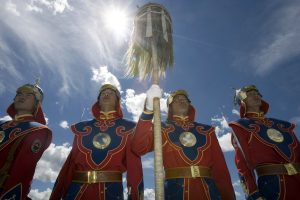Thirty years ago, a youth-led revolution upended Mongolia’s Soviet government and triggered a momentous transition toward multiparty democracy. Now, as the young Mongols of the past form the old guard of the present, the first Mongolians to live their entire lives under a democratic system are on the rise. In her upcoming book (to be released July 22), Young Mongols, Aubrey Menard tells the stories of Mongolia’s dynamic youth. The book builds upon a video series Menard produced while living in Mongolia, a piece of which ran here at The Diplomat in 2016 – highlighting the development of media in the country.
In this interview with The Diplomat’s Catherine Putz, Menard explains the role of the youth in the 1990 revolution, the lasting impact of the revolution on the country’s domestic and foreign affairs, and the challenges the country’s current young adults are tackling head-on.
What were the lasting domestic consequences of the 1990 transition?
While Mongolia’s democracy appeared to be off to a strong start following the 1990 revolution, its economy was in shambles. So-called “shock therapy” reforms that had been introduced by Western financial institutions quickly led to widespread suffering and wealth inequality. Mongolian scholar Undariya Tumursukh writes that “any action to question the direction or the pace of the reforms in an attempt to protect the society from the rapid enforcement of market rules was condemned as anti-democratic, ‘revisionist, or worse, communist.’”
Western consultants with little understanding of Mongolia devised a system to privatize 330 of the country’s state-owned enterprises, issuing citizens ownership vouchers for their shares in the newly created stock exchange. While perhaps a sound idea in theory, these consultants failed to consider their program’s real-world application. They quickly saw that when you give an average Mongolian battling poverty who has lived their entire life under a closed authoritarian communist system a voucher for a Western-inspired stock exchange, they will quickly sell it for basic provisions to the first person who offers an exchange. And so, by 2003, 0.5 percent of the population owned 70 percent of the shares of these previously collective resources. The market system, which Mongolians were sold as coming part and parcel with successful democracy, had quickly created vast inequality, which conversely impeded the country’s democratic development for years to come.
Around the same time, Canadian-based Ivanhoe Mines discovered the Oyu Tolgoi copper and gold deposit. With the discovery of Oyu Tolgoi, impoverished Mongolians learned that they were sitting on a deposit valued at $60 billion — nearly 60 times the country’s annual gross domestic product (GDP) at the time. Mongolians were led to believe that the discovery would transform their country and their lives. In 2011, as mining-related investment flooded in, Mongolia had the world’s fastest-growing economy. However, just a few short years later, the Mongolian economy was in such dire straits that in 2017 the country received the fourth-largest bailout in IMF history (proportionate to GDP). The mining project has been plagued by the legacies of corruption and unequal wealth distribution born from Mongolia’s tumultuous political and market transition. Positive benefits from the project have been slow to reach the average Mongolian, which has contributed to heightened societal tension and an erosion of faith in the democratic process.

































